
About UsThe Numismatic Bibliomania Society is a non-profit organization promoting numismatic literature. For more information please see our web site at coinbooks.org SubscriptionsThose wishing to become new E-Sylum subscribers (or wishing to Unsubscribe) can go to the following web page link MembershipThere is a membership application available on the web site Membership Application To join, print the application and return it with your check to the address printed on the application. Membership is only $15 to addresses in the U.S., $20 for First Class mail, and $25 elsewhere. For those without web access, write to: David M. Sundman, Secretary/TreasurerNumismatic Bibliomania
Society AsylumFor Asylum mailing address changes and other membership questions, contact David at this email address: dsundman@LittletonCoin.com SubmissionsTo submit items for publication in The E-Sylum, just Reply to this message, or write to the Editor at this address: whomren@coinlibrary.com
BUY THE BOOK BEFORE THE COINYou won't regret it! |
- WAYNE'S WORDS: THE E-SYLUM AUGUST 14, 2011
- NBS MEMBER TOM WETTER RECOVERING FROM MOTORCYCLE ACCIDENT
- NBS EVENTS AT THE 2011 CHICAGO ANA CONVENTION
- KOLBE & FANNING NUMISMATIC BOOKSELLERS AT 2011 CHICAGO ANA
- SKLOW NUMISMATIC LITERATURE AUCTION SALE # 14 CATALOG AVAILABLE
- THE S.S. CENTRAL AMERICA TREASURE: LATEST INSIGHTS AND RESEARCH
- REMINDER: WILLIAM A. BURD NUMISMATIC LIBRARY TOUR AUGUST 19, 2011
- 1783 NOVA CONSTELLATIO PATTERN COINS ON DISPLAY AT 2011 CHICAGO ANA
- NEW BOOK: COLT CYLINDER SCENES, 1847-1851
- NEW BOOK: A HANDBOOK FOR COLLECTING THE NEW NATIONAL PARK QUARTERS
- BOOK REVIEW: STANDARD CATALOG OF GERMAN COINS
- BOOK REVIEW: COIN WORLD ALMANAC, 8TH EDITION
- WHITMAN PUBLISHING TITLES NOW AVAILABLE ON PORTABLE MEDIA PLAYERS
- KRAUSE PUBLICATIONS PROMOTES ABBOTT PRESS FOR NUMISMATIC AUTHORS
- QUERY: 1847 FIRST RESTRIKE HALF CENT INFORMATION SOUGHT
- QUERY: MAVERICK MOOSE COUNTERSTAMP INFORMATION SOUGHT
- MORE ON BRENNER'S FOOTBALL MEDAL
- NOTES FROM E-SYLUM READERS: AUGUST 14, 2011
- GLEANINGS FROM RECENT NUMISMATIC PERIODICALS: AUGUST 14, 2011
- MORE STOLEN DOCUMENTS TURN UP IN LANDAU'S POSSESSION
- DIRTY MONEY: ALL BANK NOTES ARE TAINTED WITH BISPHENOL A
- MORE ON AUTHORIZED U.S. MINT FACILITIES
- PHILADELPHIA MINT VISITOR CENTER RENOVATIONS
- ARTICLE: WHEN MONEY BROUGHT US TOGETHER
- 3,000 ROMAN 3RD CENTURY COINS FOUND IN WALES
- ANOTHER SMALL COIN GONE: INDIA DROPS THE 25 PAISE COIN
- COLLECTING LOTTERY TICKETS
- BARGAIN PRICED CONDER TOKENS
- ALL THAT GLITTERS IS NOT GOLD
- FEATURED WEB PAGE: THE TALE OF OFFA AND THE ARABIC COIN
WAYNE'S WORDS: THE E-SYLUM AUGUST 14, 2011

Among our new subscribers this week are Ray Glahn, and Alexa Kopyan. Welcome aboard! We have 1,444 email subscribers, plus 156 followers on Facebook, including Ecureuil Inoffensif and Gregory Meyer.
This week we open with news about an NBS member recovering from a roadway accident. Next up are couple items related to this week's American Numismatic Association convention in Chicago - we have several in this issue. I hope to see some of you there.
This week we also have announcements of two new books and reviews of two others, including the new edition of the Coin World Almanac. Other topics this week include Brenner's football medals, the 1783 Nova Constellatio patterns, Conder Tokens and collecting lottery tickets.
To learn more about the 1857-S double eagle "Spiked Shield" variety, the Numismatic Auction Lot Glut, W.L. Ormsby's designs, bisphenol A and "Brenner foot", read on. Have a great week, everyone!
Wayne Homren
Numismatic Bibliomania Society
NBS MEMBER TOM WETTER RECOVERING FROM MOTORCYCLE ACCIDENT
Tom writes:
I'm actually doing very well considering what the alternative could have been, and I thank God every day that I'm not 6 feet under. I'm finally off the morphine and getting around a bit. I went the plates, screws, staples and stitches route and availed myself to as many hospital services as I could. It's been what seems like forever now, but physical therapy is definitely helping.
I will say this, with the downtime I have, I am going through my library (with my brother doing the lifting for me!) and was even thinking about the Wiki. At least now you know why there have been no recent updates! I intend on starting up on it again relatively soon as I catch up on things. I really wish I could have gone to the ANA and met up and toured Bill Burd's library. That would have been an awesome time.
NBS EVENTS AT THE 2011 CHICAGO ANA CONVENTION
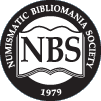 The Annual NBS convention activities are almost here! Next week on Thursday, August 18, the activities kick off with the NBS symposium at 11:30 am to 1 pm in room #21 at the Rosemont Convention Center. Joel Orosz and Len Augsburger will deliver a presentation on their new book about the U.S. Mint. Don't forget to find the numismatic literature dealers you know and love (mentioned in The E-Sylum) on the bourse floor before and after the symposium. A deluxe copy of Joel and Len's new book will be passed around at the symposium for signatures, and later will be featured in the annual NBS auction. The auction will take place at the regular annual NBS meeting on Friday, August 19, at 11:30 to 1 pm in room #7 at the Convention Center.
The Annual NBS convention activities are almost here! Next week on Thursday, August 18, the activities kick off with the NBS symposium at 11:30 am to 1 pm in room #21 at the Rosemont Convention Center. Joel Orosz and Len Augsburger will deliver a presentation on their new book about the U.S. Mint. Don't forget to find the numismatic literature dealers you know and love (mentioned in The E-Sylum) on the bourse floor before and after the symposium. A deluxe copy of Joel and Len's new book will be passed around at the symposium for signatures, and later will be featured in the annual NBS auction. The auction will take place at the regular annual NBS meeting on Friday, August 19, at 11:30 to 1 pm in room #7 at the Convention Center.
The votes have been counted for the annual NBS writing awards. The Jack Collins award (best new author in the Asylum) goes to Harvey Stack for "The Stack Family Library Sale." The award for the Best Article goes to Frank Campbell for "Fifty Years in a Numismatic Library." Frank was the ANS Librarian for decades and still resides in New York. He will not be able to attend the convention this year, so we would like to acknowledge his award and wish him well. Harvey Stack will be attending the convention and is making plans to be at the general NBS meeting on Friday, August 19, from 11:30 to 1 pm. In accepting the award, Harvey might be persuaded to share a few numismatic highlights. The full agenda for the NBS meeting is outlined below:
- Member introduction
- Literature Dealer Announcements regarding future sales
- Treasury Report and Board meeting summary
- NBS member input
- Election Results and confirmation
- Regular awards presentation. The Jack Collins award for best new writer, and the Writers Award for best overall article.
- A few interesting stories by Harvey Stack
- The Al Hoch special Kolbe award presentation. John Adams and Charlie David to present. The Hoch Family will be attending.
- Speaker presentation, Elizabeth Hahn, ANS Librarian, on the new and improved ANS Web Site.
- The Annual NBS Auction. There will be many interesting numismatic literature items including the deluxe signed copy of Joel and Len's new book on the U.S. Mint. The price ranges will be from $10 to many hundreds of dollars. Something for everyone. If you have a neat item you would like to donate to the NBS auction, bring it along. As an added feature, Dan Hamelberg, current NBS president, and Dan Freidus, next NBS president, will be handling the auction duties. All welcome.
- Wrap up comments.
After looking over the agenda, it would appear that the NBS regular meeting may take a bit longer than 1 and 1/2 hour. Harvey likes to talk, and we like to listen. Please allow more time. We look forward to seeing all the NBS members, and those who want more information on Numismatic Literature as well. See you there!
For all event times and locations, see: EVENTS AT THE CHICAGO 2011 ANA CONVENTION (www.coinbooks.org/events/index.html)
KOLBE & FANNING NUMISMATIC BOOKSELLERS AT 2011 CHICAGO ANA
 Kolbe & Fanning look forward to seeing you next week at the 2011 American Numismatic Association World's Fair of Money, August 16–20 in Rosemont, Illinois, near Chicago O'Hare airport. The public show hours are Tuesday through Saturday, from 9:00 am to 5:30 am, and George or David plan to be at table 533 during the entire show.
Please stop by
Kolbe & Fanning look forward to seeing you next week at the 2011 American Numismatic Association World's Fair of Money, August 16–20 in Rosemont, Illinois, near Chicago O'Hare airport. The public show hours are Tuesday through Saturday, from 9:00 am to 5:30 am, and George or David plan to be at table 533 during the entire show.
Please stop by
- to say hello
- to view a few of the highlights to be sold at our January 2012 Public Auction Sale in New York at the Waldorf-Astoria Hotel in conjunction with NYINC. On view will be one of only two known examples of the COLONEL GREEN COLLECTION INVENTORY; a complete set, also only the second known, of Stack's COLONEL GREEN PHOTOGRAPHIC ALBUMS of U.S. QUARTER EAGLES, HALF EAGLES, AND EAGLES; and an original 1514 edition of the first numismatic book, Budé's DE ASSE ET PARTIBUS EIUS
- to discuss the possible consignment of important works to our January 2012 Public Auction Sale in New York or to discuss how K&F may be of service in other ways, now or in the future
- to talk about our upcoming September 15th mail-bid sale (those on our mailing list should receive their printed catalogues well before the convention)
- to let us know if you like our new and improved website: www.numislit.com
- to view a small portion of our stock of rare and important numismatic works which will be available for sale
- or?
Thanks. We hope to see you at the show.
George and David
KOLBE & FANNING LLC
NUMISMATIC BOOKSELLERS
141 W JOHNSTOWN ROAD
GAHANNA OH 43230-2700
Ofc: (614) 414–0855
Cell: (614) 256–8915
Fax: (614) 414–0860
df@numislit.com
www.numislit.com
SKLOW NUMISMATIC LITERATURE AUCTION SALE # 14 CATALOG AVAILABLE
 Numismatic Literature Auction Sale # 14 Closing Saturday October 15, 2011 is now on line at our web site:
www.finenumismaticbooks.com
.
Printed catalogs will ship on or about September 1st.
Numismatic Literature Auction Sale # 14 Closing Saturday October 15, 2011 is now on line at our web site:
www.finenumismaticbooks.com
.
Printed catalogs will ship on or about September 1st.
David Sklow-Fine Numismatic Books
P.O. Box 6321
Colorado Springs, CO 80934
PH: 719-302-5686
FAX: 719-302-4933
EMAIL: numismaticbooks@aol.com
WEB: FineNumismaticBooks.com
THE S.S. CENTRAL AMERICA TREASURE: LATEST INSIGHTS AND RESEARCH
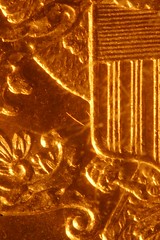 I would like to extend a personal invitation to NBS members and E-Sylum readers to attend my Numismatic Theater presentation at the ANA in Chicago on Saturday, August 20 at 10 AM - The S.S. Central America Treasure: Latest Insights and Research. I will talk about the shipwreck, its history, and recovery of the treasure as an extended introduction.
I would like to extend a personal invitation to NBS members and E-Sylum readers to attend my Numismatic Theater presentation at the ANA in Chicago on Saturday, August 20 at 10 AM - The S.S. Central America Treasure: Latest Insights and Research. I will talk about the shipwreck, its history, and recovery of the treasure as an extended introduction.
But the latter part of this talk will be about my experiences with the numismatic study of the various die varieties of early San Francisco Mint double-eagles during the curatorial process, a study made possible by the amazing number of high quality pieces, numbering in the thousands. The work was also made possible by Dwight Manley, who supported the original determination of the die varieties during the six-month curatorial program in 2000, and by Adam Crum, who supported and encouraged me to compile my decade-old notes and photographs and finish the study. The results will be included in the next edition of the book by Douglas Winter and Adam Crum about Type I double eagles (exact title to be determined), to be published by Whitman sometime around the beginning of 2012.
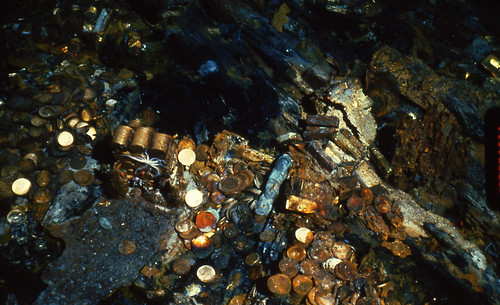
The "Garden of Gold" - the SS Central America treasure as found on the shipwreck
My life with this treasure was and is a unique honor, and I relish the opportunity to present the results of my studies at this venue. I would be pleased to see you there.
REMINDER: WILLIAM A. BURD NUMISMATIC LIBRARY TOUR AUGUST 19, 2011
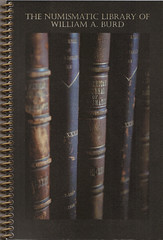 As noted in the last issue, a tour of the Numismatic Library of William A. Burd is planned for Friday August 19th from 3PM to 5PM. Cocktails & Hors D'oeuvres will be served. There will be bus service from the ANA Convention departing at 2PM and returning by 6PM. Because of limited seating this event is by invitation only. If you received an invitation and have not replied please email Bill at
wildburd@att.net
. Bill still expects to have a few seats available on the bus so if you did not receive an invite but would like to attend send him a note.
As noted in the last issue, a tour of the Numismatic Library of William A. Burd is planned for Friday August 19th from 3PM to 5PM. Cocktails & Hors D'oeuvres will be served. There will be bus service from the ANA Convention departing at 2PM and returning by 6PM. Because of limited seating this event is by invitation only. If you received an invitation and have not replied please email Bill at
wildburd@att.net
. Bill still expects to have a few seats available on the bus so if you did not receive an invite but would like to attend send him a note.
I'll be there and I'm looking forward to seeing Bill's library. I hope to see a number of E-Sylum readers at the event as well. Below are links to some earlier E-Sylum articles about his library.
To read the earlier articles, see:
CHICAGO COIN COMPANY NUMISMATIC LIBRARY OPEN FOR VISITORS' USE
(www.coinbooks.org/esylum_v12n05a07.html)
ARTICLE PROFILES BILL BURD AND HIS NUMISMATIC LIBRARY
(www.coinbooks.org/esylum_v13n29a14.html)
1783 NOVA CONSTELLATIO PATTERN COINS ON DISPLAY AT 2011 CHICAGO ANA
 An exhibit featuring the Nova Constellatio pattern coins, including three coins that were considered for the first coinage of the newly formed United States of America will be on display at booth #1057 during the American Numismatic Association World's Fair of Money®.
An exhibit featuring the Nova Constellatio pattern coins, including three coins that were considered for the first coinage of the newly formed United States of America will be on display at booth #1057 during the American Numismatic Association World's Fair of Money®.
These coins were originally conceived as the first coinage of the US, immediately following its creation. In 1783, the coins test coins (or "pattern coins") were minted as a prelude to mass production. The coins were the bit (100 units), the quint (500 units) and the mark (1,000 units), and it was hoped they would provide a standardized coinage as a replacement for the coins then circulated by the various states, whose values were not uniform. They are called Nova Constellatio (meaning "New Constellation") after the inscription on the obverse which accompanies an all-seeing eye and 13 stars.
Pictured here with the Nova Constellatio pattern coins is 2009 Philadelphia Expo exhibitor Kimberly Godinho, noted numismatic artist.
Mary Counts of Whitman adds:
There are four coins included in this exhibit. The 1783 copper five unit, 1783 Bit 100 Silver, 1783 Quint 500 Silver, and the 1783 Mark 1,000 Silver.
David Crenshaw of Whitman adds:
Visitors to the exhibit will receive a free six-page souvenir reprint of Coin World's 1980 coverage of the famous pattern coins, including interviews with John J. Ford, Jr. Whitman will also raffle off copies of The Secret History of the First U.S. Mint and other books that study the early coinage of the United States. Supplies of the souvenir Coin World reprint are limited and copies are available on a first-come-first-served basis.
Bill Burd writes:
The Type II Quint will be on display and for sale at my table (1306) at the ANA.
There are two 500 unit silver quint coins, but each is a different variety. They share the same reverse die but have different obverse dies. The variety commonly known as type 1 weighs 134.6 grains according to the Garrett catalog and 133.98 according to Breen with a diameter of 27 mm and has the standard design. It has the same provenance as the mark and is also in the Garrett Auction Catalog as item 620. This variety has a thee petal rosette located in the space midway between the start of NOVA and the end of CONSTELLATIO. Also there is a stop between the A in NOVA and the C in CONSTELLATIO. On the reverse there is a stop on either side of the date.
The other variety, known as type 2 is lighter at 109.6 grains according to the Garrett catalog and 109.72 grains according to Breen and has a somewhat smaller diameter of 24 mm. The obverse die has a different rendering of the central design and has no legend. Also, it has a solid ring border with an outer beaded border, while all other varieties have only a beaded border. On the reverse this variety seems to use the same die as type 1, but at the stop before the date there is what appears to be a die break, giving the appearance of a colon rather than a stop with another small break at the tip of the nearest leaf. This example was owned by Parmelee, Ellsworth, Garrett and is now in the collection of Walter Perschke. Earlier provenance information is unknown, although it is thought Sylvester Crosby may have owned the coin at one time; it is illustrated as item 621 in the Garrett sale.
To read the complete article, see: The Nova Constellatio Patterns of 1783: The Quint (www.coins.nd.edu/ColCoin/ColCoinIntros/NovaPatterns.intro.html)
Bill Burd adds:
Walter Perschke, the owner of the Quint, is asking $3 Million.
THE BOOK BAZARRE
NEW BOOK: COLT CYLINDER SCENES, 1847-1851
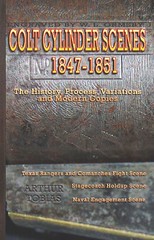 COLT CYLINDER SCENES begins with an in-depth look at W.L. Ormsby's working methods in light of early 19th century engraving practice. The transition from currency design to the rolling of revolver cylinders is detailed. The rest of the book examines the three major cylinder Scenes that Ormsby created for Sam Colt's percussion revolvers. The history of each Scene, its inspiration, and Ormsby's working methods are covered in depth. Changes in the Colt use of Ormsby's Scenes are traced to a particular series of incidents in the engraver's professional life in the mid-1850s. Modern copies of the cylinder Scenes are illustrated, as well as methods for detecting their fraudulent use.
COLT CYLINDER SCENES begins with an in-depth look at W.L. Ormsby's working methods in light of early 19th century engraving practice. The transition from currency design to the rolling of revolver cylinders is detailed. The rest of the book examines the three major cylinder Scenes that Ormsby created for Sam Colt's percussion revolvers. The history of each Scene, its inspiration, and Ormsby's working methods are covered in depth. Changes in the Colt use of Ormsby's Scenes are traced to a particular series of incidents in the engraver's professional life in the mid-1850s. Modern copies of the cylinder Scenes are illustrated, as well as methods for detecting their fraudulent use.
As much as this book is about Ormsby's designs for Colt, it is also about how that work was the outgrowth of the engraver's broader range of training and work, to include popular prints such as the Declaration of Independence, a copy of which hangs in the White House, as well as the familiar currency work. Several never-before-published images are used, including Ormsby's watercolor and ink original of the Naval Engagement Scene, and the 1841 lithographic image of Comanches fighting by George Catlin, that makes its way into the Texas Rangers and Comanches Fight Scene.
Art Tobias adds:
In my book I make the argument that while virtually all Ormsby's currency work was a product of the 19th century version of clip art made possible by the transfer press, for Samuel Colt he created all new imagery much like the unit system he unsuccessfully proposed in BANK-NOTE ENGRAVING.

Texas Rangers cylinder Scene
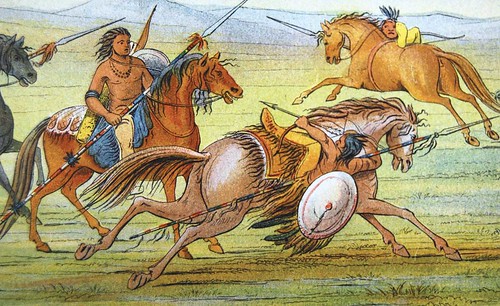
The Catlin color lithograph from Ormsby's 1841-London-published book NORTH AMERICAN INDIANS
NEW BOOK: A HANDBOOK FOR COLLECTING THE NEW NATIONAL PARK QUARTERS
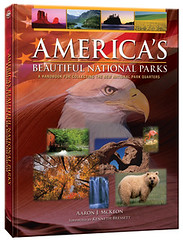 Whitman Publishing has released America's Beautiful National Parks: A Handbook for Collecting the New National Park Quarters, by Aaron J. McKeon, with a foreword by Kenneth Bressett. The hardcover, 144-page book retails for $19.95, and is available online (including at WhitmanBooks.com), and from bookstores and hobby shops nationwide.
Whitman Publishing has released America's Beautiful National Parks: A Handbook for Collecting the New National Park Quarters, by Aaron J. McKeon, with a foreword by Kenneth Bressett. The hardcover, 144-page book retails for $19.95, and is available online (including at WhitmanBooks.com), and from bookstores and hobby shops nationwide.
Starting last year and running through the year 2021, Americans are enjoying an exciting new coinage program—one that honors national parks and sites in each of the fifty states, plus our five territories and the District of Columbia. These new quarter dollars follow the popular state and territorial quarters of 1999–2009, which introduced millions of Americans to the joys of coin collecting.
America's Beautiful National Parks offers awe-inspiring panoramic photographs and stories about each site honored in the new coin series. Readers also learn about the quarters themselves—how their designs are chosen, how they go from sketch to final layout, a gallery of the program's first coins, and more.
"America's Beautiful National Parks is more than just a visually stunning art book with historical essays," said Whitman publisher Dennis Tucker. "It's a handbook for outdoor adventurers as well as coin collectors."
Appendix D offers a "Traveler's Checklist of U.S. National Parks and Sites," listing all of our nationally protected areas. Readers can focus on their home state and check each local park as they visit them. Or they can expand their scope nationwide and check the parks off as they learn about each with their children or grandchildren. "Many people who would not have looked twice at their pocket change will become interested in coin collecting because of this U.S. Mint program," writes McKeon. "They will be hooked by the history, artistry, culture, and friendships that the hobby offers."
America's Beautiful National Parks: A Handbook for Collecting the New National Park Quarters
By Aaron J. McKeon; foreword by Kenneth Bressett
ISBN 0794828892
Hardcover, 8.5 x 11 inches
Full color
$19.95
BOOK REVIEW: STANDARD CATALOG OF GERMAN COINS
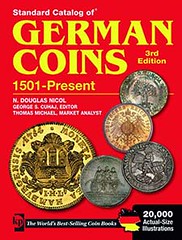 The fragmentation of the Holy Roman Empire of the German Nation into a rather enormous number of more often tiny entities proved proverbial to contemporaries. With more than 1,800 individual states (from powerful kingdoms, duchies, countships, various principalities and ecclesiastical entities down to individual cities and imperial knights) being part of this empire in the 17th century, not only due to a highly differentiated image of stately organisation and weakened central (i.e. imperial) power, but also a numismatist's nightmare as far as numbers and especially the diversity of material as well as regional monetary systems are concerned.
The fragmentation of the Holy Roman Empire of the German Nation into a rather enormous number of more often tiny entities proved proverbial to contemporaries. With more than 1,800 individual states (from powerful kingdoms, duchies, countships, various principalities and ecclesiastical entities down to individual cities and imperial knights) being part of this empire in the 17th century, not only due to a highly differentiated image of stately organisation and weakened central (i.e. imperial) power, but also a numismatist's nightmare as far as numbers and especially the diversity of material as well as regional monetary systems are concerned.
This volume of Krause Publication's series of catalogues deals with the coinage of Germany and German states from the beginning of the 16th century to the present (earlier editions commenced with the year 1601). The period covered hence ranges from the creation of a huge silver coin as equivalent to the (gold) Gulden, that is from the advent of the Taler and its wide usage during the 16th and 17th centuries, to the downfall of the Empire at hands of Napoleon's armies in 1806; the various monetary unions among German states (and Austria) in the 19th century to the creation of a united Germany in 1871; the catastrophes of WW I and II and the separation into two German states along the borders of the Iron Curtain; and finally, the fortunate unification of East and West Germany in 1990, followed by the inauguration of the Euro in 2002.
Although, after 1871, the identification of a coin and its issuing authority as ‘German' will represent no problem, the contrary holds true for earlier times. As the Holy Roman Empire included territories which today belong to France, Belgium, the Netherlands, Switzerland, Poland and others, the decision to include or exclude a certain issue is always delicate and will follow a rather pragmatic approach: hence, while those of present-day Austria are excluded (minted under the authority of the Habsburg emperors), those from German dominated Silesia, which became a part of Prussia only in 1740 when taken from the Austrians, are included; as are coins from Alsace-Lorraine, which fell under French domination at the end of the 17th century and only from 1871-1918 was part of the German Empire.
The second main obstacle to cataloguing and identifying all issues in question is a rather simple one: because of the high number of minting authorities involved, the state of numismatic research into these coins is similarly diverse. Some have recently and satisfyingly been covered by modern research, while for others we still lack up-to-date coin catalogues and mint histories which would provide essential information on mintage numbers, mintmasters, monograms and mintmarks, respectively. Base metal coins and fractions (in contrast to the more precious Taler and gold coins, ducats and gulden) in particular are mostly unpublished yet and await their renewed appreciation in private and museum collections.
The creation of such a ‘Standard Catalog' from a German perspective, therefore, represents a somewhat daring, but laudable, enterprise, which allows for a number of unanswered questions and imponderability cleared away only with each subsequent edition, much in contrast to the psychology of the German numismatic community and scholarly mind. This is why it comes as no surprise to the reviewer that this catalogue covering 500 years of German coinage was produced in the US rather than in Germany (comparable collectors' guides in German go back in time only as far as 1700).
It is beyond doubt that this ‘Standard Catalog' strongly benefits from N. Douglas Nicol's access to German numismatic research and publications in the field. Coins are listed chronologically beginning with the lowest denomination. Mintages are given where available; prices are provided in five grades, though with mintage numbers in most cases lacking, no differentiation for individual annual issues can be provided. In accordance with the series, KM# denotes database numbers (searchable on the Krause website), not subsequent and self-explanatory catalogue numbers within each entity.
Being a compilation of known (and published) types combined with valuations, this 3rd edition of the ‘Standard Catalog of German Coins 1501 to Present' constitutes an extremely helpful and appreciable tool for anybody collecting and handling German coins or dealing in German numismatics. Besides being the only existing reference of this kind so far (compare the reasons mentioned above), it provides the first and most elementary step into the appreciation of the subject.
To read the complete article, see: "A daring enterprise": the ‘Standard Catalog of German Coins' in a New Edition (www.coinsweekly.com/en/News/4?&id=730)
BOOK REVIEW: COIN WORLD ALMANAC, 8TH EDITION
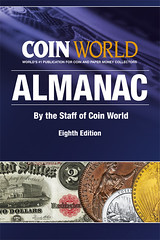 The latest, eighth, edition of the Coin World Almanac arrived in the mail yesterday, August 13th. Hardly time for a full scale analysis or review, but occasion for a number of comments.
The latest, eighth, edition of the Coin World Almanac arrived in the mail yesterday, August 13th. Hardly time for a full scale analysis or review, but occasion for a number of comments.
It has been eleven years since the last, 7th -- Millennium Edition. But one wonders how editor Beth Deisher and her crew have the time to prepare the latest almanac with her enhanced publication schedule of an increased number of publications with large size issues, even with an eleven year hiatus.
I hold the Coin World Almanac in high regard. When the Numismatic Bibliomania Society held a survey of the 100 Greatest American Numismatic books, the CW Almanac was noticeably absent. I wrote a Contrarian View of this Survey. Published in The Asylum (Spring 2009) where I listed my top 25 books on their suggest list, but I added 25 more that were not on the NBS list.
The CW Almanac ranked number 9 on that list overlooked by the NBS surveyors. I wrote "I am jealous of the entire Coin World Staff for compiling this Almanac. This is exactly what I wanted to compile for the numismatic field, but they beat me to it." I should add, congratulations!
In a sentence I summarized this book: Useful data for everyone who writes in the field covering the full spectrum of numismatics.
The latest edition comes close but does not entirely fulfill that statement. It is heavy on coins and paper money, light on all other areas of numismatics. It seems to be very heavy on bullion coins and counterfeit coins. There are twice the number of pages on how counterfeit coins are made in contrast to the number of pages on how legitimate coins are made.
The back cover touts the "most comprehensive U.S. mintage figures published." I still have a tendency to check the Red Book for these because of the pictures. The Almanac is devoid of illustrations, so I can find mintage figures quicker, guided by the purdy pictures.
But one table alone draws me to the CW Almanac, overcoming any other source: Specifications of U.S. Coins (pages 286-289). Here is a one-stop data file for weight, size, composition of all U.S. coins. Very useful.
Of course, the editors have updated so many sections, rarest (that is, highest prices) of U.S. coins, news for the intervening years, numismatic chronologies, and chapter 23 of interest to E-Sylum readers on books and periodicals.
References to URLs for further information are contained throughout the book. Excellent feature.
The number of total pages in recent CW Almanacs have been diminishing. The second edition (1977) had a sumptuous 1002 pages. The latest is down to 678, but the format is a somewhat taller page size, a wider column width, and I swear the type size seems smaller to these 81-year-old eyes. But I am concerned more with content.
I have two copies of the third edition. That volume had a magnificent section on medals, with lists of both space medals and those issued for the American Bicentennial -- the only such published source in numismatics. No specialize lists like that in recent issues. Pity.
The first CW Almanac issues bore the motto: "Complete, Concise, Informative." I wish that were the case for the issue at hand. Heavy on coins and paper money, light on everything else of numismatic interest. Or is it, the information is so good, I just want more?
For more information, see: COIN WORLD ALMANAC (8th Edition) (www.coinworld.com/dealers/amos-press/coin-world-almanac-8th-edition/)
WHITMAN PUBLISHING TITLES NOW AVAILABLE ON PORTABLE MEDIA PLAYERS
Whitman Publishing announces the release in digital format of more than a dozen of its most popular numismatic books, including the 2012 Red Book and Blue Book. The titles are now available on multiple devices such as the iPad, Amazon Kindle, and Nook. They can be ordered through Apple, Barnes and Noble, Amazon.com, Kobo, Sony, and other ePub outlets. Prices range from $4.99 to $29.99.
Whitman has released books on DVD in the past. The ePub releases are its first for portable media players.
"While coin and paper-money collecting is an antiquarian hobby, collectors and dealers do embrace modern technology," said Whitman publisher Dennis Tucker. "To serve those who want to access their favorite books electronically, Whitman will continue to roll out additional titles in ePub format in the coming weeks."
The first round of releases includes the 2012 editions of the Guide Book of United States Coins (the "Red Book") and the Handbook of United States Coins (the "Blue Book"); the Cherrypickers' Guide to Rare Die Varieties (Fivaz and Stanton); Grading Coins by Photographs (Bowers); 100 Greatest U.S. Modern Coins (Garrett and Schechter); 100 Greatest American Currency Notes (Bowers and Sundman); the United States Gold Counterfeit Detection Guide (Fivaz); America's Money, America's Story (Doty); Adventure Across the States: Collecting State Quarters and Other Coins; History of the United States Mint and Its Coinage (Lange); Coin Collecting: A Beginner's Guide to the World of Coins (Bressett); and the Bowers Series guide books on Lincoln cents, Buffalo and Jefferson nickels, Washington and State quarters, and Morgan silver dollars. All are currently available online.
Whitman Publishing has been a leader in the numismatic publishing field since 1934. The company's Guide Book of United States Coins, now in its 65th edition, has seen more than 22 million copies in print, making it one of the best-selling nonfiction books in United States publishing history.
KRAUSE PUBLICATIONS PROMOTES ABBOTT PRESS FOR NUMISMATIC AUTHORS
Your hobby is more than just a hobby. A profession, a weekend leisure activity, a craft, an interest, a skill -- no matter what you call it, it's your passion.
With the help of Abbott Press -- part of the F+W Media family, just like Krause Publications -- you now have a way to publish a book dedicated to the topic or field that you're most passionate about.
If you have been looking to publish a book about coin or paper money collecting, Abbott Press' NEW color publishing packages include all the support and services to get your book designed, published and distributed with your personal needs and goals in mind.
Whether the topic is Tokens, Morgan Dollars or Fractional Currency, Abbott Press allows you to present your favorite stories and images in a vibrant full-color book.
Use the book to promote your business, show your expertise, or pass down your skills and passion for future generations.
Fill out the form on this page to request your complimentary consultation or call (866) 697-5310 to speak with an Abbott Press Publishing Specialist.
QUERY: 1847 FIRST RESTRIKE HALF CENT INFORMATION SOUGHT
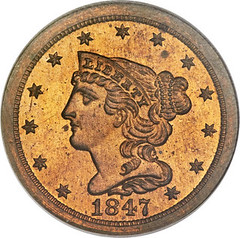
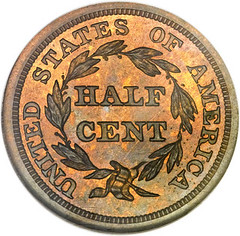
Mark Borckardt writes:
Heritage Auctions will be offering an 1847 First Restrike half cent in our September Long Beach sale. This piece is one of just two or three known, and it has a provenance back to the 1906 Chapman sale of the H.P. Smith Collection, and the 1912 Henry Chapman sale of the George Earle Collection. In that regard, I am seeking anyone who has an annotated copy of the Earle catalog. I would like to know the buyer of Lot 3673 in that sale. Please email markb@ha.com.
QUERY: MAVERICK MOOSE COUNTERSTAMP INFORMATION SOUGHT
Dick Hanscom writes:
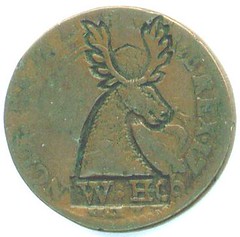 I don't know why I have not sent this in sooner!
I have owned this for 30+ years and don't have a clue about it. Perhaps some E-Sylum reader might.
It is counterstamped on a 1790-M France 1 Sol.
I don't know why I have not sent this in sooner!
I have owned this for 30+ years and don't have a clue about it. Perhaps some E-Sylum reader might.
It is counterstamped on a 1790-M France 1 Sol.
GOING TO THE 2011 WORLD'S FAIR OF MONEY IN CHICAGO?
MORE ON BRENNER'S FOOTBALL MEDAL
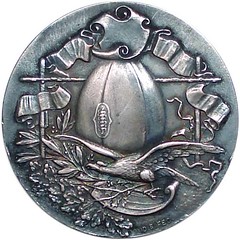
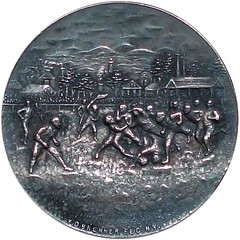
The Victor D. Brenner Football Medal which Jonathan Brecher inquired about is well known to Brenner medal collectors. Brenner medals have been cataloged six times and this Football Medal is number 1 in both the Grolier Exhibit Catalog and in the Hahlo Catalog.
These two catalogs plus the 1911 ANS catalog, International Exhibition of Contemporary Medals, covered only a small portion of Brenner's entire medallic production. Even Glen Smedley, with the resources of the American Numismatic Association, where he worked while he complied his Brenner list included only 120 items. It was published in The Numismatist with one later supplement.
My research on Brenner's medallic work now stands at 303 different items and seems to grow yearly with newly attributed items.
The Football Medal is one of two varieties. Jonathan's specimen is the most common. This variety was donated to the American Numismatic Society in 1894, the year he engraved it. The second variety was donated to ANS in 1897. It can be identified by its acquisition number 1897.147.153.
The year 1894 was important as the year Brenner found full-time employment with the engraving firm of Robert Stoll, in New York City. Stoll tended to specialize somewhat in sports medals; the Amateur Athletic Union was one of its major clients. It a two year period he engraved 18 undated medals that I am aware, and an equal number of dated medals for this firm.
This earned for him enough revenue bring the remainder of his family, parents and siblings, by ship passage to New York. And within another two years additional revenue for Brenner to travel to Paris to study under Louis Oscar Roty, who had, perhaps, the greatest influence on Brenner's career. It transformed him form a hand engraver, carving his dies exact size, to model the designs oversize and have his models reduced by pantographic reduction.
Jonathan is correct in that there is no name on his football medal, indicating it was not prepared for a specific client. Brenner could have done it on speculation -- that it could have been used by some future client -- or it could have been prepared to prove his skill and craftsmanship to the Robert Stoll management. Or, he could have done it just for the fun of it -- he was enamored by the distinctively American sport.
Stoll continue to issue AAU medals long after Brenner left the Stoll firm to study in France, ultimately to replace a die by his hand with that of another engraver. However, experienced medal collectors have a diagnostic to identify a Brenner die, whether it is signed or not. He did the bare foot on the female figure on the AAU medal in a distinctive way. Art critics call this a "mannerism." I call it a "Brenner foot." No other American medallist modeled or engraved a foot like Brenner did.
Dave Hirt adds:
After reading about the Brenner football medal, I pulled my catalog of the Stoff collection. He had an extensive collection of Brenner medals, 60 plus lots, some with multiple pieces. The football medal was the first lot listed, with the date given as 1894. The championship teams that year were Yale 16-0, and Pennsylvania 12-0.
The other sports medals listed in the sale were Lake George Regatta Association Award Medal 1902,The Amateur Athletic Union of the United States Gold Award Medal 1903 Indiana AAU Championship medal of 1920,and Metropolitan Association of the AAU Championship Medal 1928. I had not looked at that catalog for a long time, and had forgotten about that fine medal collection.
Regarding acquisition number 1897.147.153, Jonathan Brecher notes:
I can't find that acquisition number in their online catalog. I did find a similar number with two digits swapped: http://numismatics.org/collection/1987.147.153. That object sounds like it's not a medal itself, but rather a steel punch with his monogram as used on this medal?
They also have a neat plaque version pictured at http://numismatics.org/collection/1987.147.9. And I guess they have the hub used to make the plaque at http://numismatics.org/collection/1987.147.152
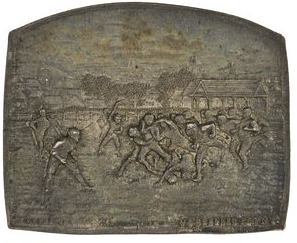
To read the earlier E-Sylum article, see: QUERY: VICTOR DAVID BRENNER FOOTBALL MEDAL INFORMATION SOUGHT (www.coinbooks.org/esylum_v14n31a09.html)
NOTES FROM E-SYLUM READERS: AUGUST 14, 2011
The Best of The E-Sylum
Dick Johnson writes:
Last week's "Best of" E-Sylum issue was a gem! It brought back a lot of favorable memories of reading these notable items originally. Wayne, can you go on vacation more often?
Not if it means that much work! The special issue was a nice idea, but in practice it took almost as much time as a normal issue to compile. But it was fun and a nice change of pace.
Mandatory Wording on U.S. Coins
Richard Doty writes:
I wish Heidi Wastweet all success. Heaven knows, we could certainly use her! But we could also use elimination of much of the verbiage that tradition or law demands that each and every coin has to carry. You can't create a decent design if your work is constantly interrupted by words, however sacred they may be. Other countries have figured out ways to give designer a chance. Why can't this one?
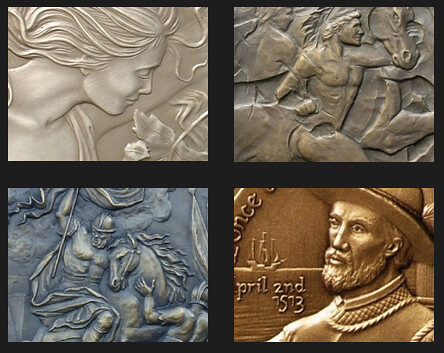
To read the earlier E-Sylum article, see: ARTICLE HIGHLIGHTS COIN DESIGNER HEIDI WASTWEET (www.coinbooks.org/esylum_v14n31a08.html)
Earl Fankhauser' s Encased Coins
Bruce Perdue writes:
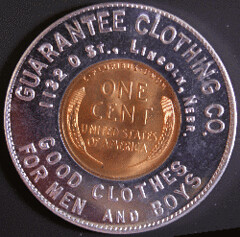 The Osborne Coin Company in Cincinnati is well known to collectors of encased coins. Earl Fankhauser the "Penny Man" from Fort Wayne, IN sold encased coins made by Osborne. Bryan Ryker wrote a book about Earl Fankhauser. Bryan had a website with copies of the Osborne ledgers of the Earl Fankhauser created encased pieces. I have with Bryan's permission provided the original article on Earl Fankhauser on my
Encased Coins
website
www.encasedcoins.info/earl_fankhauser.html
.
The Osborne Coin Company in Cincinnati is well known to collectors of encased coins. Earl Fankhauser the "Penny Man" from Fort Wayne, IN sold encased coins made by Osborne. Bryan Ryker wrote a book about Earl Fankhauser. Bryan had a website with copies of the Osborne ledgers of the Earl Fankhauser created encased pieces. I have with Bryan's permission provided the original article on Earl Fankhauser on my
Encased Coins
website
www.encasedcoins.info/earl_fankhauser.html
.
I have provided a page on the Osborne Coin Company here www.encasedcoins.info/osborne.html with links to scans of the ledgers. One of my future projects is to convert these images to an actual searchable database. There are 20 years of ledgers from 1949 -1969. Bryan was able to get access to the ledgers...perhaps other will also.
To read the earlier E-Sylum article, see: THE OSBORNE COINAGE COMPANY OF CINCINNATI, OH (www.coinbooks.org/esylum_v14n31a05.html)
The Numismatic Auction Lot Glut
Alan V. Weinberg writes:
It does seem to me to be entirely too many coins suddenly coming on the market at the time of the Chicago ANA show. I just read , I believe on Legend's website, there are over 10,000 auction lots. In this economy? What effect will this auction " load" have on bourse sales?- I'd guess a heavy toll. We'll see. Most auction sessions start well before the bourse closes for the evening- something I'm astonished the ANA permitted.
On Editors
Ray Williams of the Colonial Coin Collectors Club writes:
I wanted to note that Syd Martin has done a fantastic job as C4 Editor! In addition to authoring a book that is now the recognized standard reference on Wood's Hibernia coinage, having another book (Rosa Americana coinage) that is just being completed and in the final editing, having several books "in the works" and being a recognized expert in most areas of colonial numismatics, Syd volunteers his time to edit and publish the C4 Newsletter. I won't embarrass him by mentioning all the not for profit organizations he's affiliated with.
Editors are an under-appreciated breed. They are in constant need of articles, put in countless hours of work and most club editors do it for the love of the hobby. All the collector sees is a finished product in their mail box (or inbox). We all too often just sit and enjoy the product without realizing what went into making it happen.
I'd just wanted to thank Syd for all his work... and you too, Wayne... and all the editors who are reading this.
GLEANINGS FROM RECENT NUMISMATIC PERIODICALS: AUGUST 14, 2011
Yesterday my son Tyler asked me what was so funny - I'd laughed while reading my copy of the latest issue (Spring 2011) of The C4 Newsletter from the Colonial Coin Collectors Club. It was this photo and caption from page 72:
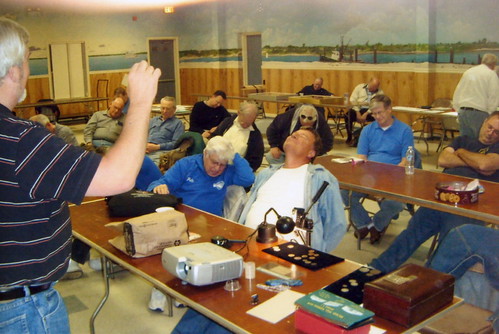
Past C4 President Ray Williams gives another fascinating talk to the Ocean County Coin Club, Point Pleasant, NJ on May 5th, 2011
Thanks to Ray Williams for sending me a copy of the photo to publish here. He writes:
The picture was taken at the Ocean County Coin Club, where I gave a presentation. Of course it was posed - my numismatic talks aren't quite as boring as the picture might indicate. I'm glad you got a laugh out of it. Too many people take themselves way too seriously. Life's too short not to laugh often and hard!
MORE STOLEN DOCUMENTS TURN UP IN LANDAU'S POSSESSION
A presidential historian has been scheming to steal valuable documents from archives throughout the Northeast for years — if not decades — and his release from federal custody could put more pieces of American history at risk if he tries to cover his tracks, a prosecutor argued Thursday.
U.S. Magistrate Judge Susan K. Gauvey approved the release of Barry Landau, 63, to his Manhattan apartment with GPS monitoring, but put the release on hold until another judge hears an appeal from prosecutors Friday afternoon.
Landau and his assistant, 24-year-old Jason Savedoff, are charged with stealing valuable historical documents from the Maryland Historical Society and conspiring to steal documents from other archives. The historian would use different routines to distract curators and had sports jackets and overcoats altered to allow him to stash documents inside large pockets, Assistant U.S. Attorney James G. Warwick said.
Warwick told the judge that the pair had some 80 documents. About 60 were from the Maryland Historical Society, including papers signed by President Abraham Lincoln worth $300,000 and presidential inaugural ball invitations and programs worth $500,000. The other documents were from the Connecticut Historical Society, Vassar College and the National Archives, Warwick said.
Investigators have twice searched the apartment Landau shared with Savedoff but are concerned that if Landau is released he could destroy documents elsewhere, Warwick said. Landau bragged that he had a storage space in the Washington, D.C., area where he had 30 times the number of paintings, documents and artifacts that he kept in his apartment — which Warwick described as "wall-to-wall" memorabilia.
"If we don't get to them first, they may be lost forever," Warwick said.
Landau's attorney, Andrew C. White, said that his client doesn't have any other repositories for documents and memorabilia, and if he said as much, it was only to boost his image.
A search of Landau's apartment last month turned up thousands of documents, Warwick said. National Archives workers have been cataloging the documents, and have determined so far that 200 belong to institutions, including Swarthmore College, the Smithsonian Institution, Yale University, Columbia University, the New York Public Library, Vassar College, Cambridge University, University of Vermont and the Library of Congress.
"These are priceless relics of history," Warwick said. "They're no longer available to the public. They've been converted for Mr. Landau's personal financial gain."
Warwick offered a peek into a "complex bundle of lies and deceit" he said the government has been uncovering. Investigators were told that Landau would offer to reframe paintings he admired in people's homes, and then return high-quality reproductions he commissioned and keep the originals, Warwick said.
To read the complete article, see: Prosecutor Urges Judge Not to Release Historian (www.artdaily.org/index.asp?int_sec=2&int_new=49649)
THE BOOK BAZARRE
DIRTY MONEY: ALL BANK NOTES ARE TAINTED WITH BISPHENOL A
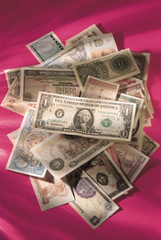 It is one of those solid facts that people spout: "All bank notes are contaminated with cocaine." Well, in this case, it could well be true. Studies on Euro notes in 2005 revealed that every note was affected while 90% of US dollars were coated with cocaine, according to results disclosed in 2009.
It is one of those solid facts that people spout: "All bank notes are contaminated with cocaine." Well, in this case, it could well be true. Studies on Euro notes in 2005 revealed that every note was affected while 90% of US dollars were coated with cocaine, according to results disclosed in 2009.
Now, you can add another statement of fact about paper currency. It is all contaminated with bisphenol A. That may not ring any immediate alarm bells but it should. BPA is recognised as an endocrine disruptor, and has been shown to cause reproductive problems and cancer in lab animals. It has also recently been linked to male infertility and may be an agent in several other diseases.
So, it was a worrying development when two scientists based in the US discovered that every bank note that they examined had BPA on its surface. Kurunthachalam Kannan and Chunyang Liao from the Wadsworth Center, New York State Department of Health, and Department of Environmental Health Sciences at the State University of New York at Albany, examined the currency of 21 different countries with the same results. Total contamination.
So, where does the BPA originate from? Its main source is industrial chemistry as a monomer for producing polycarbonate plastics which are used in the manufacture of plastic bottles, construction materials such as roofing, electronic components, computer discs and DVDs, among others.
Small sections were removed from the bottom left and top right corners and the middle of each of the 51 notes with a hole punch and they were spiked with a deuterated BPA internal standard.
The sections were extracted with methanol for analysis by LC/MS on a C18 column. BPA was eluted with an increasing flow of methanol in water for electrospray ionisation in negative-ion mode, followed by multiple reaction monitoring for BPA and the standard. The recovery was estimated at 105 ± 14.3% and the detection limit was 0.5 ng/g.
All bank notes were contaminated with BPA at amounts ranging from 0.001-82.7 µg/g. In most cases, the BPA levels in the centres of the notes were higher than at the corners, with mean values of 6.26 ± 13.2 µg/g compared with 4.18 ± 9.93 and 4.37 ± 11.4 µg/g for the lower left and upper right corners.
The levels in the corners might be lower because they are handled more often than the centres of the bank notes, encouraging transfer to the hands, but the research duo offered another explanation which was related to a proposed mechanism for currency contamination in the first place.
It is known that cash register receipts produced on thermal paper have a thin coating of BPA. So, it is possible that BPA is transferred from a receipt to a bank note when the two are placed together in a wallet. The centres of the receipts and currencies are likely to be in contact the most.
This theory was tested by placing seven bank notes from five countries next to thermal receipt paper for 24 hours in wallets before the currency was analysed for BPA as before. Notes with low initial levels of BPA displayed 100- to 1000-fold increases in concentration after contact, whereas those with high initial concentrations increased two-fold.
So, this transfer mechanism does appear to be feasible. This was supported by the fact that the BPA levels on older bank notes were higher than on newer ones, the longer circulation periods allowing more time for transfer and accumulation.
To read the complete article, see:
Dirty money: All bank notes are tainted with bisphenol A
(www.separationsnow.com/coi/cda/detail.cda?
id=25967&type=Feature&chId=4&page=1)
MORE ON AUTHORIZED U.S. MINT FACILITIES

Tom DeLorey writes:
The "Best of E-Sylum" article from 2010 on "How Many Mint Buildings" for some strange reason compels me to wax pedantic. Did not the "Ye Olde Firste Philadelphia Minte" actually consist of multiple buildings that need be counted?
David Ganz adds:
... and of course the Capitol. (Washington). Numerous commemorative coin proposals have been introduced, and several were enacted. In 1987, the Olympics were commemorated for 1988 (even though the United States was not a host). The following year, the bicentennial of Congress was commemorated with a special coin, and on June 9, 1989, the United States capitol was authorized to become a United States Mint for a single day, when a first strike ceremony was authorized.
Tom DeLorey adds another footnote-worth facility to the list. He writes:
Also, the mythical, fabled and long-lost 1964-D Peace dollars were struck in a different building across the street from the Denver Mint.... should it be counted as well?
To read the earlier E-Sylum article, see: E-SYLUM'S BEST: HOW MANY DIFFERENT MINT BUILDINGS? (www.coinbooks.org/esylum_v14n32a05.html)
PHILADELPHIA MINT VISITOR CENTER RENOVATIONS
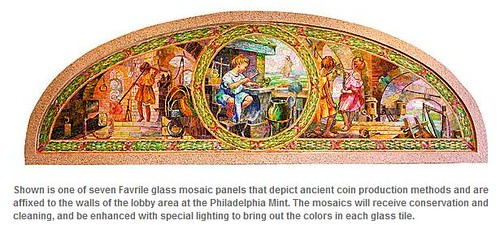
Preparations are on target for the beginning of construction in October of new and revitalized exhibits to enhance the visitors center and tour at the Philadelphia Mint.
The new exhibit areas and displays are to be put in place and unveiled to the public sometime in the spring, according to Tom Jurkowsky, director of the U.S. Mint's Office of Public Affairs.
Designs for the new interactive, video and static displays, with audio augmentation, are currently being finalized by Quatrefoil, the Laurel, Md., firm contracted by the U.S. Mint under a $3.9 million accord inked on Aug. 18, 2010.
Abbie Chessler, Quatrefoil's co-founding partner and head of design, said Aug. 4 that the firm has been working closely with the U.S. Mint's historian, curatorial staff and other Mint personnel on the exhibit design process as well as determining which of the "heritage assets" currently on display will remain and what other items might be substituted.
"Heritage assets" represent coins, medals, models, documents and other historical items associated with production of money in general, and by the U.S. Mint and Philadelphia Mint specifically.
While the renovated, redesigned and enhanced visitors areas will still include a self-guided tour of the production floor viewed from the third floor, Chessler said the intent is to make the experience more enjoyable for the more than 250,000 people who visit the Philadelphia facility annually. The viewing area is 40 feet above the production floor.
Enhanced exhibits will also be displayed throughout the first floor lobby and second floor mezzanine.
Among the current highlights that will continue to be featured in the expansive lobby area of the fourth Philadelphia Mint are the seven glass mosaic panels — two oblong and five round — executed under the direction of Louis B. Tiffany for display at the third Philadelphia Mint on Spring Garden Street upon its opening in 1901.
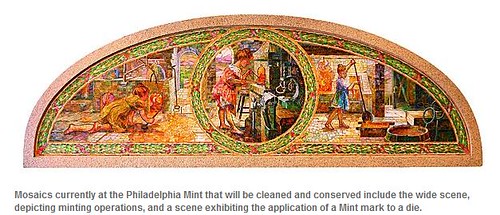
To read the complete article, see: Renovations set for Philadelphia Mint center (www.coinworld.com/articles/renovations-set-for-philadelphia-mint-center/)
ARTICLE: WHEN MONEY BROUGHT US TOGETHER
Dick Johnson writes:
There's a long, long article headlined "When Money Brought Us Together" by history professor Stephen Mihm in today's Boston Globe He tells of conditions in early America and draws the conclusion that you need to unify people before having a currency. That is why the Euro is not achieving the intended purpose of unifying people in Eurozone countries. Interesting article, albeit economic.
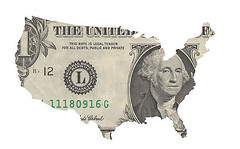 As the American economy reckons with the fallout of the debt-limit crisis, it's easy to forget about the far bigger train wreck underway in Europe, where the continent's grand experiment with a common currency is becoming more imperiled by the day. The euro, the powerful currency unveiled to great fanfare a little over a decade ago as a symbol of a new, united continent, is quickly becoming a victim of the very nationalist infighting that prompted its creation in the first place.
As the American economy reckons with the fallout of the debt-limit crisis, it's easy to forget about the far bigger train wreck underway in Europe, where the continent's grand experiment with a common currency is becoming more imperiled by the day. The euro, the powerful currency unveiled to great fanfare a little over a decade ago as a symbol of a new, united continent, is quickly becoming a victim of the very nationalist infighting that prompted its creation in the first place.
All of this threatens to deliver a crippling blow to Europe, with grave repercussions for the broader global economy. But the more immediate casualty of the ongoing crisis is the optimism at the root of the euro itself - the belief that the nations of Europe might move beyond their history of internecine strife by uniting under the banner of a common currency.
That belief now seems naive to many people. And the very notion that disparate nations might be brought together by a single currency looks increasingly absurd. But currency unions have a deeper history then just the euro, and a look at their record over time suggests that currency unions have, indeed, worked. In fact, we're living in one: The dollar is itself the product of a long struggle to unite America's states and businesses under a single currency.
America's road to the unified dollar was not easy, and its early struggle, never mind the long history of failed attempts to stretch other currency unions beyond national borders, offers a sobering lesson for euro-optimists. This is not to suggest that the euro project is doomed. It is, however, a problematic idea. It is one thing to create a currency union within national borders; it is a very different matter to argue that a shared currency can unite people across them.
Officially speaking, the American dollar was born even before the Constitution was signed. But the actual money supply of the young United States was far from uniform. Anyone doing business here in America's first few decades would have encountered thousands of different notes issued by private banks. These were usually redeemed not in dollars issued by the United States mint, but in silver coins from places like Mexico and Bolivia. Travelers also found that merchants and storekeepers often reckoned prices not in dollars and cents, but in local versions of pounds and shillings that varied in value from place to place. European visitors to the United States frequently commented on the heterogeneity of the new nation's money.
To read the complete article, see:
When money brought us together
(www.boston.com/bostonglobe/ideas/articles/2011/08/14/
when_money_brought_us_together/)
3,000 ROMAN 3RD CENTURY COINS FOUND IN WALES
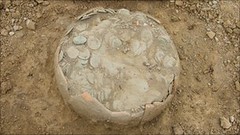 The hoard of copper alloy coins, dating from the 3rd Century, was unearthed in Montgomery, Powys, several weeks ago.
The hoard of copper alloy coins, dating from the 3rd Century, was unearthed in Montgomery, Powys, several weeks ago.
About 900 were found by a member of a Welshpool metal detecting club, with the rest of the discovery made with help from archaeologists.
The exact location is being kept secret to protect the site. The Powys coroner will determine whether they qualify as treasure.
Clwyd-Powys Archaeological Trust (CPAT), which helped unearth the coins, said the discovery had the potential to reveal more about Roman life in mid Wales in the late 3rd Century.
The find in Montgomery is a few miles away from where a Roman fort once stood in the village of Forden.
The majority of the coins were found buried in a ceramic pot, said the trust.
"The hoard has the potential to tell us more about Roman life in mid Wales in the late 3rd Century AD.
"This was probably a time of considerable political and economic unrest and the coins may have been buried for safekeeping with the intention of returning for them in the future.
"Unfortunately for the original owner, but happily for us, for some reason they never had the chance to recover them."
The coins were taken to the National Museum Wales in Cardiff, where an expert is writing a report.
To read the complete article, see: 3,000 Roman 3rd Century coins found in Montgomery field (www.bbc.co.uk/news/uk-wales-mid-wales-14307381)
KOLBE & FANNING SEPTEMBER 15, 2011 SALE HIGHLIGHTS
Key Works and Multi-Volume Sets on Ancient Coins
Including: Complete sets of BMC Greek, Roman Provincial Coinage, Davenport on Crowns and Talers, Duruy on Rome and Greece, Hahn's Moneta Imperia Byzantine, A Finely Bound Set of de Saulcy's 1836 Work on Byzantine Coins, A Complete Set of the Typos Monographs, Etc. Also, Georges Le Rider's Copies of Svoronos on the Coins of the Ptolemies, Babelon on Syria and on Persia, and Newell on Eastern and Western Seleucid Mints
Catalogue Available soon at Our Web Site: www.numislit.com
Printed Catalogues $10.00
KOLBE & FANNING NUMISMATIC BOOKSELLERS
141 W JOHNSTOWN ROAD, GAHANNA OH 43230-2700
(614) 414-0855 • df@numislit.com • GFK@numislit.com
ANOTHER SMALL COIN GONE: INDIA DROPS THE 25 PAISE COIN
 A couple of months ago, India bid goodbye to the char anna – the 25 paise coin. From 1 July, this coin ceased to be legal tender.
A couple of months ago, India bid goodbye to the char anna – the 25 paise coin. From 1 July, this coin ceased to be legal tender.
In practical terms, it means everything now has to priced in multiples of 50 paise. At the current rate of inflation, which is 8-10 percent, the Re 1 coin will be worth 50 paise by around 2018-20.
Put another way, by the end of this decade, the 50 paise coin, too, will have no reason for existence, as nothing will really be priced below Re 1. It will all have to be in multiples of rupees.
When the 50 paise disappears, the concept of the paisa will itself become history. Reason: there will be no physical currency—note or coin—that will physically denote the paisa.
For practical purposes, since we have the decimal system, we may still have prices quoted as Rs 10.99, but in future this transaction can be executed only when you pay by credit card or buy multiple items and write off the balance paise.
That is, you can buy 10 kg of alu priced at Rs 10.90 a kg and pay Rs 109 in currency, but you can't buy one kg of it at Rs 10.90. You will pay Rs 11.
The paisa, if it exists, will exist only in cyberspace, in digital accounts and smart cards. Only the rupee will exist in hard cash – notes or coins.
To read the complete article, see:
The paisa will soon be history; the rupee is the new pais
(www.firstpost.com/economy/the-paisa-will-soon-be-history
-the-rupee-is-the-new-paisa-59569.html)
COLLECTING LOTTERY TICKETS
Early lottery tickets share a lot in common with colonial paper money - they were often printed by the same printers on similar paper with similar images and markings. Many were authorized by local and state governments, and signed by government officials and various dignitaries of the day. -Editor
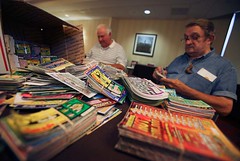 Among the mountains of losing lottery tickets piled high in a hotel conference room, someone may yet hit a jackpot. But it won't be money that makes the winner. For members of the Global Lottery Collector's Society, the scratch-off cards themselves are worth keeping because of their quirky themes and colorful designs.
Among the mountains of losing lottery tickets piled high in a hotel conference room, someone may yet hit a jackpot. But it won't be money that makes the winner. For members of the Global Lottery Collector's Society, the scratch-off cards themselves are worth keeping because of their quirky themes and colorful designs.
From a $3 Montana lottery ticket based on the game Uno to a series of $2 "Star Trek" stubs from Virginia, the game themes run the gamut from movies and TV shows to sports teams and holiday cheer. The cards come in different sizes, shapes and denominations.
"The whole purpose of collecting is not to get rich, or to get lucky, but to get the tickets," said club co-founder Bill Pasquino. "But if I happen to hit a jackpot along the way, I'd be very happy."
Last weekend, Pasquino joined about two dozen other club members at the group's annual "Lotovention." Held this year in northeast Philadelphia, the gathering is an opportunity to meet other self-described "lotologists," trade tickets and take a gander at the never-ending multitude of collectible material.
Pasquino, 64, a retired teacher from Lancaster, Pa., said that when the club started in the late 1980s, only about a dozen states had lotteries — and none would issue more than six tickets per year.
Today, 43 states plus Washington, D.C., Puerto Rico and the U.S. Virgin Islands have lotteries, as do countries across the world.
Pennsylvania alone issues between 55 and 65 new instant games a year, according to state lottery spokeswoman Elizabeth Brassell. Recent scratch-offs include the $10 "Stacks of Cash" ticket — top prize $200,000 — and the cheaper $1 "Dice Doubler," with a jackpot of merely $2,000.
While the club focuses on modern scratch-off tickets, lotteries in the U.S. date to Colonial times. Princeton University's library boasts a collection of tickets from 1761-1826, noting that lotteries were common sources of public financing because there were relatively few banks.
Benjamin Franklin financed cannons for the Revolutionary War through lotteries, while Thomas Jefferson disposed of most of his estate through such tickets, according to Princeton archives.
To read the complete article, see: Lottery Ticket Collectors Eye Keepsakes, Not Money (www.artdaily.org/index.asp?int_sec=2&int_new=49769)
BARGAIN PRICED CONDER TOKENS
 Q. David Bowers was president of Paramount International Coin Corporation before I went with the company in 1967. Before he left, he made a trip to Great Britain and must have hired a separate boat to bring back all his plunder. It was a great variety of material. I do not recall what all there was but there were many, many rolls of 1950 and 1951 British pennies, a large quantity of silver crowns and a goodly number of copper Conder tokens.
Q. David Bowers was president of Paramount International Coin Corporation before I went with the company in 1967. Before he left, he made a trip to Great Britain and must have hired a separate boat to bring back all his plunder. It was a great variety of material. I do not recall what all there was but there were many, many rolls of 1950 and 1951 British pennies, a large quantity of silver crowns and a goodly number of copper Conder tokens.
I was with Paramount five years and year after year those British coins appeared on the inventory sheets. They were going nowhere. I am a sucker for beauty. The Conder tokens were truly magnificent.
When I was making plans to leave Paramount, I knew they wanted desperately to move some of this material from Great Britain. I had a chance to "buy low." (See my story on investing.) Whether I could "sell high" I did not know, but with the Conder tokens, I did not care. I wanted them around just to look at. They were that appealing. I bought all of the Conder tokens, several of the 1950 and 1951 pennies and several crowns.
I sold all the crowns to an investor who was a doctor in Troy, Ohio, for little more than the bullion value and dribbled out the other material over time.
Finally I decided to take the Conder tokens to a show. I left Barbara at the table while I went out to work the floor to make show expenses the easy way. My instructions to Barbara were, "I want $40 each for the tokens, $35 if someone takes them all." I came back to the table in a short time and Barbara greeted me happily with the news that she had sold all the Conder tokens.
"What did you get?"
"$35." She had sold the whole group which I had prized so highly for a total of $35 instead of $35 each.
To read the complete article, see: Conder Tokens Teach Pricing Lesson (www.numismaster.com/ta/numis/Article.jsp?ad=article&ArticleId=22913)
ALL THAT GLITTERS IS NOT GOLD
Lincoln police say they've arrested a woman who tried to trick a coin dealer into buying so-called gold coins.
Police say the dealer met Stacey Sellner in April at a convenience store under the premise of buying gold coins. Authorities say Sellner sprayed the dealer in the face with pepper spray. The dealer pushed Sellner out of his car, and she took off.
Officer Katie Flood says police found two gold coins in the parking lot - they were chocolate wrapped in gold foil.
To read the complete article, see:
Woman arrested for in gold coin caper in Lincoln
(www.nebraska.tv/story/15252789/woman-arrested-
for-in-gold-coin-caper-in-lincoln)
FEATURED WEB PAGE: THE TALE OF OFFA AND THE ARABIC COIN
This week's Featured Web Page is " The Tale of Offa and the Arabic Coin" from Susan Wise Bauer's " The History of the (Whole) World" blog.Once upon a time, a king named Offa ruled in the English kingdom of Mercia. Offa, who reigned c. 757-796, had a (relatively) huge empire, big enough so that Charlemagne treated him as an honored colleague. (Not as an equal, but then Charlemagne didn't treat anyone as an equal. Their friendship endured until Offa suggested that his son and heir marry one of Charlemagne's daughters, at which point Charlemagne was highly offended and broke off contact. But that's another story).
And here's Offa (he was rich and powerful enough to mint his own coins, some of which have survived with his portrait on them).
Late in Offa's reign, one of his money-makers designed him a new coin. On one side, it says "Offa Rex." And on the other, it says, "There is no God but Allah, and Muhammad is his prophet."
How did this happen?

www.susanwisebauer.com/blog/tales-from-history/
the-tale-of-offa-and-the-arabic-coin/
